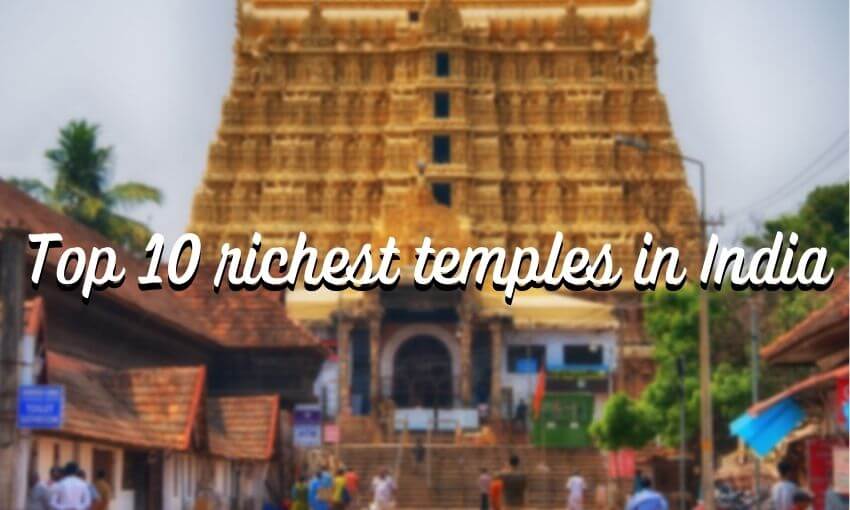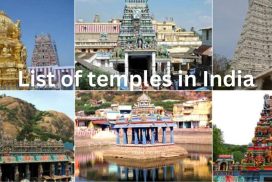India is home to some of the most beautiful and sacred temples in the world. These temples are not only places of worship but also a source of immense wealth. The top 10 richest temples in India are a testament to the immense wealth and power of these religious institutions. From the famous Tirupati Balaji Temple in Andhra Pradesh to the Shirdi Sai Baba Temple in Maharashtra, these temples are some of the most visited and revered places of worship in India. Each of these temples has its own unique history and significance, and they are all known for their immense wealth. In this article, we will take a look at the top 10 richest temples in India and explore their history, significance, and wealth.

The Role of the Richest Temples in India in Preserving Cultural Heritage
The richest temples in India have played a major role in preserving the country’s cultural heritage. These temples are not only places of worship, but also serve as repositories of India’s rich cultural heritage.
The temples are home to some of the most exquisite works of art, architecture, and sculpture. These works of art are often centuries old and are a testament to the skill and creativity of the people who created them. The temples also house some of the most important religious texts, which are a source of knowledge and inspiration for many.
The temples also serve as a repository of India’s cultural heritage. They are often the site of important festivals and celebrations, which are a way of preserving the traditions and customs of the country. The temples also serve as a place of pilgrimage for many people, who come to pay their respects to the gods and goddesses.
The temples also serve as a source of income for many people. They are often the site of businesses, such as restaurants, shops, and hotels. This provides employment for many people and helps to keep the economy of the country running.
The temples also serve as a source of education. Many of the temples have schools and colleges, which provide education to the people of the country. This helps to ensure that the cultural heritage of the country is preserved and passed on to future generations.
The temples also serve as a source of inspiration for many people. They are often the site of religious ceremonies and rituals, which are a way of connecting with the divine. This helps to keep the faith alive and helps to ensure that the cultural heritage of the country is preserved.
In conclusion, the richest temples in India have played a major role in preserving the country’s cultural heritage. They are home to some of the most exquisite works of art, architecture, and sculpture. They are also a source of income for many people, a source of education, and a source of inspiration. All of these things help to ensure that the cultural heritage of the country is preserved and passed on to future generations.
The Impact of the Richest Temples in India on Local Communities
The richest temples in India have had a huge impact on local communities. These temples are often seen as a source of wealth and prosperity, and they have been known to bring in a lot of money to the local area. This money is often used to fund various projects and initiatives that benefit the local community.
For example, many of the richest temples in India have been known to provide free education to local children. This has had a huge impact on the local community, as it has allowed more children to get an education and have a better chance at success in life. This has also helped to reduce poverty in the area, as more children are able to get an education and find better jobs.
The money from the richest temples in India has also been used to fund various health initiatives. This has had a huge impact on the local community, as it has allowed more people to access healthcare and receive treatment for various illnesses and diseases. This has helped to reduce the mortality rate in the area, as more people are able to receive the medical care they need.
The money from the richest temples in India has also been used to fund various infrastructure projects. This has had a huge impact on the local community, as it has allowed more people to access better roads, electricity, and other amenities. This has helped to improve the quality of life in the area, as more people are able to access the resources they need to live a better life.
Overall, the richest temples in India have had a huge impact on local communities. They have provided free education, healthcare, and infrastructure projects that have helped to improve the quality of life in the area. This has allowed more people to access the resources they need to live a better life, and it has helped to reduce poverty in the area.
The History Behind the Richest Temples in India
India is home to some of the world’s most impressive and wealthiest temples. These temples are not only places of worship, but also serve as a symbol of India’s rich cultural heritage. From the ancient times, temples have been a source of immense wealth and power.
The most famous and richest temple in India is the Sri Padmanabhaswamy Temple in Kerala. This temple is dedicated to Lord Vishnu and is believed to be one of the 108 Divya Desams, or holy abodes of Vishnu. It is believed to be one of the oldest temples in India, with its origins dating back to the 8th century. The temple is renowned for its immense wealth, with its vaults containing gold and jewels estimated to be worth billions of dollars.
The Tirumala Venkateswara Temple in Andhra Pradesh is another famous and wealthy temple in India. This temple is dedicated to Lord Venkateswara, an incarnation of Lord Vishnu. It is one of the most visited temples in India, with millions of devotees visiting it every year. The temple is believed to be one of the eight Swayam Vyakta Kshetras, or self-manifested shrines of Lord Vishnu. It is also believed to be the richest temple in India, with its annual income estimated to be around Rs. 1,000 crore.
The Shirdi Sai Baba Temple in Maharashtra is another famous and wealthy temple in India. This temple is dedicated to the 19th century spiritual leader Sai Baba of Shirdi. It is one of the most visited temples in India, with millions of devotees visiting it every year. The temple is believed to be one of the richest temples in India, with its annual income estimated to be around Rs. 500 crore.
The Golden Temple in Amritsar is another famous and wealthy temple in India. This temple is dedicated to the Sikh Guru, Guru Nanak. It is one of the most visited temples in India, with millions of devotees visiting it every year. The temple is believed to be one of the richest temples in India, with its annual income estimated to be around Rs. 300 crore.
These are just some of the most famous and wealthiest temples in India. Each of these temples is a symbol of India’s rich cultural heritage and a source of immense wealth and power.
How the Richest Temples in India Generate Their Wealth
India is home to some of the world’s most famous and wealthiest temples. These temples are not only places of worship, but also major sources of income for the local communities. So, how do these temples generate their wealth?
One of the main sources of income for these temples is donations from devotees. People from all over the world come to visit these temples and offer donations in the form of money, jewelry, and other items. These donations are then used to maintain the temple and its activities.
Another way these temples generate wealth is through the sale of religious items. Many of these temples have their own shops where devotees can buy religious items such as idols, incense, and other items. These items are then sold to devotees, generating a steady stream of income for the temple.
The temples also generate income through the sale of prasadam, which is a type of food offering made to the gods. Prasadam is usually made from fruits, nuts, and other ingredients and is then sold to devotees. This is another way these temples generate income.
Finally, some of the wealthiest temples in India also generate income through tourism. These temples attract millions of visitors each year, who come to experience the beauty and grandeur of these ancient sites. The temples then charge a fee for visitors to enter, generating a significant amount of income.
Overall, the wealthiest temples in India generate their wealth through a combination of donations, religious item sales, prasadam sales, and tourism. These temples are not only places of worship, but also major sources of income for the local communities.
Exploring the Richest Temples in India: A Look at the Top 10
India is home to some of the most beautiful and opulent temples in the world. From the Golden Temple in Amritsar to the Meenakshi Temple in Madurai, these places of worship are a testament to the country’s rich cultural heritage. But which temples are the richest? Here’s a look at the top 10 richest temples in India.
1. Tirumala Venkateswara Temple
Located in Tirupati, Andhra Pradesh, this temple is the richest in India. It is dedicated to Lord Venkateswara and is visited by millions of devotees every year. The temple is said to have an annual income of over Rs. 1,000 crore.
2. Shirdi Sai Baba Temple
Located in Shirdi, Maharashtra, this temple is dedicated to the 19th-century spiritual leader Sai Baba. It is one of the most popular pilgrimage sites in India and is said to have an annual income of over Rs. 500 crore.
3. Siddhivinayak Temple
Located in Mumbai, Maharashtra, this temple is dedicated to Lord Ganesha. It is one of the most visited temples in India and is said to have an annual income of over Rs. 300 crore.
4. Padmanabhaswamy Temple
Located in Thiruvananthapuram, Kerala, this temple is dedicated to Lord Vishnu. It is one of the oldest temples in India and is said to have an annual income of over Rs. 200 crore.
5. Jagannath Temple
Located in Puri, Odisha, this temple is dedicated to Lord Jagannath. It is one of the most important pilgrimage sites in India and is said to have an annual income of over Rs. 150 crore.
6. Kashi Vishwanath Temple
Located in Varanasi, Uttar Pradesh, this temple is dedicated to Lord Shiva. It is one of the most sacred temples in India and is said to have an annual income of over Rs. 100 crore.
7. Meenakshi Temple
Located in Madurai, Tamil Nadu, this temple is dedicated to Goddess Meenakshi. It is one of the most beautiful temples in India and is said to have an annual income of over Rs. 75 crore.
8. Golden Temple
Located in Amritsar, Punjab, this temple is dedicated to Guru Nanak. It is one of the most important pilgrimage sites for Sikhs and is said to have an annual income of over Rs. 50 crore.
9. Vaishno Devi Temple
Located in Jammu, Jammu and Kashmir, this temple is dedicated to Goddess Vaishno Devi. It is one of the most visited temples in India and is said to have an annual income of over Rs. 40 crore.
10. Sai Baba Temple
Located in Shirdi, Maharashtra, this temple is dedicated to Sai Baba. It is one of the most popular pilgrimage sites in India and is said to have an annual income of over Rs. 30 crore.
These temples are not only some of the richest in India, but also some of the most important pilgrimage sites in the country. They are a testament to the country’s rich cultural heritage and are a source of inspiration for millions of devotees.
Conclusion
The top 10 richest temples in India are a testament to the immense wealth and power of the Hindu religion in India. These temples are a source of pride and inspiration for many Hindus, and they are a reminder of the importance of faith and devotion in India. The wealth of these temples is a reflection of the dedication and commitment of the devotees who visit them. The temples are also a source of economic activity, providing employment and income to many people in the local area. The top 10 richest temples in India are a symbol of the strength and resilience of the Hindu faith in India.
Content from other States:
- No items




